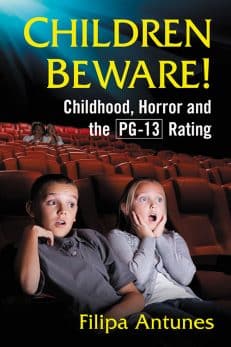Children Beware!
Childhood, Horror and the PG-13 Rating
Original price was: $39.95.$31.99Current price is: $31.99.
In stock
About the Book
How does a culture respond when the limits of childhood become uncertain? The emergence of pre-adolescence in the 1980s, which is signified by the new PG-13 rating for film, disrupted the established boundaries between childhood and adulthood. The concept of pre-adolescence affected not only America’s pillar ideals of family and childhood innocence but also the very foundation of the horror genre’s identity, its association with maturity and exclusivity.
Cultural disputes over the limits of childhood and horror were explicitly articulated in the children’s horror trend (1980–1997), a cluster of child-oriented horror titles in film and other media, which included Gremlins, The Gate, the Goosebumps series, and others. As the first serious analysis of the children’s horror trend, with a focus on the significance of ratings, this book provides a complete chart of its development while presenting it as a document of American culture’s adaptation to pre-adolescence. Each important children’s horror title corresponds to a key moment of ideological negotiation, cultural power struggles, and industrial compromise.
About the Author(s)
Bibliographic Details
Filipa Antunes
Format: softcover (6 x 9)
Pages: 214
Bibliographic Info: appendix, notes, bibliography, index
Copyright Date: 2020
pISBN: 978-1-4766-7133-8
eISBN: 978-1-4766-3895-9
Imprint: McFarland
Table of Contents
Acknowledgments vi
Introduction. Read If You Dare: The Problem of Children and Horror 1
• Pre-Adolescence, a Millennial “Discovery” 3
• Horror and the Childhood/Adulthood Frontier 7
• PG-13: A Critical Milestone 12
• Eye of the Storm: The Children’s Horror Trend 14
• A Map for the Road Ahead 21
Part I: Rupture 23
1. “This could be our Exorcist!” Disney, Horror and the New Rules of Childhood 25
• Learning New Rules: Ron Miller’s Disney, 1978–1983 27
• A Ghastly Landmark: The Watcher in the Woods 31
• Conclusion: Miller’s Last Effort 42
2. Parents Strongly Cautioned: PG-13, a Cultural Turning Point 44
• Discussing Classification: A History of Not Asking All the Questions 45
• The Poltergeist Before the Storm 50
• Temple of Doom: The Children Will Scream with Delighted Horror! 52
• Gremlins Against America 55
• Conclusion 62
3. Horror vs. Children: Confronting Young Audiences After PG-13 65
• Establishing an Identity: PG-13 from 1984 to 1989 67
• Quintessential Children’s Horror: The Gate 72
• Whose Genre Is It? The Gate, The Lost Boys, The Monster Squad 77
• Conclusion 82
Part II: Negotiation 85
4. Backlash: The R-Rated 1990s 87
• Restoring Horror’s Maturity: Back to the 1970s? 88
• So What of Children’s Horror? 99
• Conclusion: The End of a Film Cycle, the Start of a New Era 106
5. The Final Conflict: Children’s Horror Meets Family Entertainment 109
• Family Values: A New Hollywood for New Cultural Attitudes 111
• A Short-Lived Truce: The Witches 115
• Closing the Cycle: Casper 121
• Conclusion 126
6. “Viewer beware … you’re in for a scare”: The Horror of
Puberty, Televised and Serialized 128
• Meanwhile, in Other Media: The Children’s Market Welcomes
Horror 129
• Building an Empire: The Goosebumps Franchise 133
• Monstrous Puberty or, When Is a Formula Something Else? 141
• Conclusion 145
Conclusion: Sometimes It Comes Back: Children’s Horror Today 149
• Summary: The Insights of Children’s Horror 150
• The (Il)Legitimacy of Children in Horror 158
• PG-13 and the End of Children’s Cinema? 161
• The Millennial Twist (or, the Generation Who Came of Age Twice) 165
Appendix: A Selection of Children’s Horror 169
• A. Before the Trend: Early Wave 169
• B. The Children’s Horror Film Cycle, 1980–1995 169
• C. The Children’s Horror Trend, 1980–1997 171
• D. After the Trend: Children’s Horror Today 172
Chapter Notes 175
Works Cited 189
Index 199





